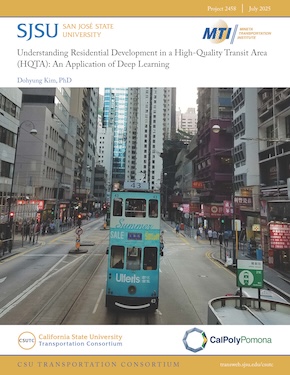- 408-924-7560
- mineta-institute@sjsu.edu
- Donate
Understanding Residential Development in a High-Quality Transit Area (HQTA): An Application of Deep Learning
Considerable research addresses the dynamics between land use and public transportation, including the impacts of transit systems on urban development and vice versa. However, this research has underestimated the heterogeneity of contributing factors to urban developments near transit by property type: vacant lot and occupied property. That is, what drives development in vacant lots differs from what drives development in already-occupied property. A lack of comprehensive data that differentiates development records based on the type of property is one explanation for this research gap. This project fills this research gap by employing a deep learning algorithm and separately examining the contributing factors to vacant lot and occupied property development near transit. A deep learning model—a foundation model—detects and classifies residential development on vacant and occupied properties in high-quality transit areas (HQTAs) in Los Angeles County. Taking the classification as the dependent variable, this research constructs two multi-level logistic regression models: vacant and occupied models. The findings confirm the heterogeneity of the contributing factors to the development of vacant and occupied parcels. The findings also indicate that while the factors at the property level are more significant than the neighborhood-level factors in both models, the significance of the property characteristics in vacant lot development is more significant than in occupied lot development. While infill development on occupied lots in core cities is more likely to occur, the inner suburban cities tend to experience residential development on both vacant and occupied properties much less than the other areas. Another interesting contrast between vacant and occupied lot development is that occupied lot development is more likely to be associated with urban functions/amenities, while the vacant lot development tends to occur in areas with tranquility (where amenities are fewer) near transit. These insights highlight the need for strategies specific to property type in transit-oriented development planning and suggest that nuanced, data-driven approaches are essential to promoting efficient urban growth around transit hubs.
Dohyung Kim, PhD
Dr. Kim is a Professor in the Department of Urban and Regional Planning at California State Polytechnic University, Pomona. Since 2009, he has taught GIS applications in planning, local transportation planning, transportation methods and analysis, and planning research methods. Dr. Kim's research and practice focus on GIS applications in sustainable transportation planning, land use and transportation dynamics, and transportation safety. His recent research includes
urban/suburban housing development in conjunction with transportation.
-
Contact Us
San José State University One Washington Square, San Jose, CA 95192 Phone: 408-924-7560 Email: mineta-institute@sjsu.edu






